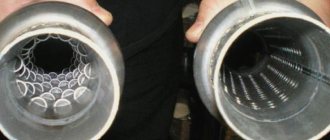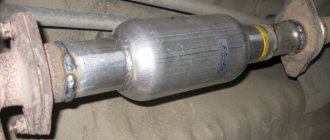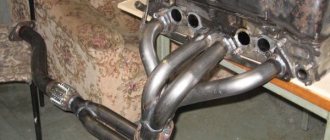What is a flame arrester?
A flame arrester is a special steel device that is placed in place of the catalyst. It tolerates high temperatures and aggressive environments well. The flame arrester is used to reduce the temperature of the exhaust, the device can also make it less noisy.
Experts in car service centers claim that the flame arrester will help extend the life of the entire exhaust system and make driving more comfortable. Craftsmen often insist that without this important element, consumption will increase significantly. But is it?
Flame arrestors: purpose, principle of operation
The flame arrester is used as a muffler resonator, reducing the temperature and energy of gases, and normalizing the functioning of exhaust system components.
The unit is resistant to mechanical stress and overheating, being adapted to the conditions formed in the combustion chamber. Each of the cylinders generates pulsating flows, converted by the flame arrester into one common, slow and cold one.
The device is exposed to vibration created by the motor, a moving muffler and an aggressive environment in the form of salt solutions and dirt falling on the heated element.
The body of the product is double-layered, since it is necessary to dampen sound waves without producing rattling sounds.
This design is resistant to the destructive effects of gases escaping from the combustion chamber.
Sound insulation is created with basalt filler or with mineral wool.
Attention! Having decided to install a flame arrester instead of a catalyst, you need to choose a device that matches in volume, since when it is insufficient, a rattling sound occurs that accompanies a sharp start.
Reducing the noise level is achieved by absorption, reflection of sound waves and through a third chamber equipped with a diffuser, where the primary processing of the flow occurs, after which it is damped by a layer of packing, and this reduces its wear.
The flame arrester is similar to a muffler resonator; as standard, it consists of a small diameter pipe in which perforated holes are made to allow gases to escape.
It is placed in a steel housing, but between it and the pipe there is a high-temperature resistant filler that dampens sound waves.
The design has an outlet and an inlet and it is better not to confuse them during installation. The end sides are welded, but can simply be rolled.
When choosing a flame arrester, you need to consider a number of key factors:
- center offset;
- diameter;
- length;
- power of the machine's power unit.
More advanced models are equipped with funnel-shaped diffusers that reduce the speed of gas jets. You need to buy a part that is resistant to anti-icing agents.
One of the best flame arresters is the MG-Race model, made of stainless steel with a high carbon content. Sprint modifications made using aluminized metal are also reliable.
Myth and reality
According to experts, on some cars oil consumption increases after the catalyst is removed - the car was initially designed in such a way that the engine runs against the pressure exerted by the catalyst. As soon as it is removed, the pressure disappears and the oil flows more freely, but certainly not in liters, as some service technicians say. And if you don’t load the engine and spin at high speeds, you won’t notice the difference.
Why is one thing replaced by another?
The catalyst can become unusable simply by exhausting its resource. This does not happen with new cars, but if the car was bought second-hand and managed to travel 150 thousand km or more, it means that the catalyst in it is seriously worn out. And since it is impossible to clean or restore it, there is only one way out: replacing it with a flame arrester.
High mileage is not the only reason for wear of the standard catalyst. It can also become unusable due to bad fuel. Unscrupulous sellers, trying to increase the octane number of their low-quality gasoline, add additives containing lead to it. Exhaust gases from such fuel cause overheating and subsequent melting of the catalyst sections.
Finally, flame arresters are installed in cars due to the high cost of branded catalysts. This is the most popular reason, especially now, when the price of catalysts has become simply prohibitive and can vary from 50 to 250 thousand rubles.
Flaws
Of course, there are some downsides. When installing it, some motors begin to “choke.” The flame arrester creates too high a pressure, due to which if the engine operates at high speeds, the dynamics deteriorate compared to a well-functioning catalyst.
So it is not at all necessary to install a flame arrester instead of a catalyst. Moreover, a high-quality element costs about 8,000 - 10,000 rubles (this does not include installation). Its service life is about 5 years.
The catalytic converter in a car serves to reduce the toxicity of exhaust gases from the engine, but in Russian conditions, the exhaust system element often becomes clogged with slag and fails.
New catalysts are expensive, and many car owners are trying to get rid of the catalytic converter (CN) and install a “dummy” instead. Whether this element needs to be cut out, and what happens after removing the catalyst, we will look at in this article.
Disadvantages of replacement
The main disadvantage is the deterioration of the environmental situation, since there is nothing left to filter the gases, because now they are not burned, and the exhaust will intensively pollute the environment.
You will have to flash the ECU or install a fake, since the car simply will not start if the sensors show an error or indicate a faulty catalyst.
Detectors measure the toxicity of exhaust and, in the absence of a filter, inform you that operation in such conditions is unacceptable. The CHECK ENGINE light will remain on continuously.
If you do the firmware, the car will comply with EURO 2 standards, whereas with a catalyst it would fall under the EURO 5 classification.
The use of a software method makes it possible to achieve smooth operation of the motor, while the resistance provided by the neutralizer is no longer taken into account.
If you install a flame arrester instead of a catalyst, the life of the muffler will be reduced, since the intensity of the flame passage increases, which also reduces the service life of pipes and resonators by 10%.
Attention! The driver and passengers will not feel a deterioration in the environmental situation, that is, gases will not enter the cabin.
Cons of Catalyst Removal
When it fails, the CN causes a lot of problems for the owner of the car. A catalytic converter that is coked and clogged with slag creates excessive resistance to exhaust gases, which reduces engine power and significantly increases fuel consumption. It becomes impossible to drive with a faulty catalyst; the car has to be repaired. The car owner has two ways out of the situation:
- install a new neutralizer;
- cut out the element that has become unusable, leaving either an empty can or welding a flame arrester instead of the catalyst.
Removing CN has its disadvantages:
- the CO level in the exhaust gases increases;
- an unpleasant ringing sound appears in the area where the flame arrester or empty can is located;
- depending on the settings of the electronic engine management system, fuel consumption may increase;
- After removing the catalyst in modern fuel systems, the electronics generate errors that need to be corrected.
Pros of replacement
Let us highlight a number of advantages that make using the machine more economical, convenient and practical:
- the flame arrester is durable and rarely breaks;
- vehicle operating costs are reduced;
- You can fill the tank with AI-92 gasoline.
Let's look in detail at what causes certain advantages caused by installing a flame arrester. The most interesting mechanism is the mechanism for increasing engine power, or, more precisely, restoring it.
The design of the catalyst makes it difficult for gases to pass through due to the abundance of small honeycombs, which are almost insurmountable. Installing a flame arrester removes resistance previously encountered along the way.
The motor begins to function easier, and this makes the iron horse faster.
Some experts intimidate inexperienced motorists with engine failure when removing the catalyst. However, this statement is absurd, since with this development of events the load on the motor is reduced.
It must be admitted that a loss of stability of the power unit is likely, but this is due to errors in configuring the ECU firmware. This can be avoided by correcting it taking into account the changed circumstances.
Kia Rio: flame arrester instead of catalyst. Video:
Error after removing catalyst
Many modern electronic engine control systems have various sensors that monitor the composition of the fuel mixture. Oxygen sensors (lambda probes) are always paired with a catalyst, and two sensors are usually installed:
- the first of them stands in front of the catalyst can, it adjusts the fuel supply and sends a signal to the engine control unit;
- the second lambda probe is located after the catalyst, it serves for diagnostics - it determines the qualitative composition of the exhaust gases.
If CI is removed from such an exhaust system, the toxicity of the exhaust gases will be higher than normal, and the diagnostic sensor will give a signal that CO is exceeded in the exhaust tract. The control unit will receive the signal and inform the driver about the error - after removing the catalyst, the Check Engine warning light on the instrument panel will light up.
How to choose a flame arrester to replace the catalyst?
If replacement is a done deal, then you need to choose a suitable flame arrester, taking into account its characteristics and service life.
They operate approximately for 3–5 years, and specific numbers determine the design features of the devices.
Collector models can last up to 6, and main modifications up to 10 years.
The shorter service life of the first type is due to its location. It is located in close proximity to the combustion chamber, so hot streams are constantly in contact with it, reducing operating time.
Trunk models are placed in such a way that the gases reaching them are already partially cooled, wearing out the product less.
Collective flame arresters suffer from a violation of the structural integrity of welds and exhaust pipes. However, here everything depends on the materials used; if the body is made of stainless steel, scalded with argon, then the system will last for decades.
Standard steel units coated with aluminum, welded with ordinary electrodes, do not last so long. This is due to the low strength of the weld, violation of which leads to the destruction of the internal partition.
The result is expressed in incorrect operation and the appearance of extraneous noise.
How to correctly replace a catalyst with a flame arrester?
It is necessary to take into account a number of features, without which it is impossible to ensure the correct operation of the vehicle:
- embedding a lambda probe to control the amount of fuel burned and the quality of the mixture in the exhaust system. When it is installed in the manifold directly in front of the neutralizer, there will be no difficulties when installing a flame arrester instead of a catalyst;
- installation of controllers that act as decoys that change the signals of oxygen detectors;
- installation of a miniature copy of the neutralizer that cleans the mixture and sends appropriate signals to the sensors.
It is required to use reliable gaskets, clamps, hangers and other fasteners to ensure the longevity of the device.
It is forbidden to tighten the pipes too much, as well as to allow the parts to be skewed relative to each other. It is forbidden to allow excessive tension on the rubber gaskets. The system must be sealed tightly using a sealant that seals all joints.
Attention! During installation, this substance must not be allowed to enter the system, as this will lead to breakdown, resulting in clogging of ceramic honeycombs.
Do-it-yourself repair of car starters and generators. - there is more useful information here.
Fuel consumption after catalyst removal
Many car owners often ask the question: can fuel consumption increase after removing the catalyst? If the catalytic converter was simply cut out, the lambda probe installed after the catalyst insert will signal an error and the ECU will put the fuel system into emergency mode:
- the engine will lose power;
- fuel consumption will increase.
But car repair workers have learned to cheat the system - they reflash the control unit and remove the second lambda probe from the circuit. The electronics “believes” that there is no second sensor in the system, so error information does not appear, and the internal combustion engine operates normally. With the “trick”, fuel consumption after removing the catalyst is almost the same as with a catalytic converter, the only difference is that the emission of toxic substances into the atmosphere with the removed CN increases.
Preliminary nuances
Let's start with the simple concept of a catalyst, which for some reason they want to replace with their own hands or the hands of a craftsman with a flame arrester. The catalyst is a device that is part of the exhaust system. It serves to purify gases produced during fuel combustion from all kinds of impurities.
But if this device breaks down or becomes dirty, returning it to its original level of performance is not so easy. In fact, car owners make one of 2 decisions. In the first case, they buy a new part and install it in place of the old one. The second option is to replace the catalyst with a device called a flame arrester. He's a strongman. At the same time, there is a lot of controversy and talk around the second method. Motorists sometimes do not understand why they should do this, what such modification will do and whether it will worsen the performance of the car.
Car enthusiasts are divided into 2 camps. Some argue that installing a stronger is an excellent tuning solution. Others are confident that such modernization will only cause harm.
But how dangerous would it actually be to remove the catalyst? And if this is harmful, then why do service stations actively offer this service in Yekaterinburg, St. Petersburg, cities such as Moscow, Voronezh, Volgograd and other parts of the country? And the price isn't that bad.
It's all about the myths that have formed around flame arresters. They look like this:
- the motor begins to quickly fail;
- the muffler breaks down;
- the engine is very noisy;
- exhaust gases become more dangerous in their composition;
- great harm is caused to nature;
- in the cabin you can be poisoned by the exhaust;
- the engine consumes fuel in huge quantities;
- motor life is reduced significantly;
- the exhaust system lasts quite a bit, etc.
But it was not in vain that I focused on the fact that these are myths. Most of them are very far from the truth.
Flashing after removing the catalyst
When a faulty catalyst is removed from a car’s exhaust system, the car “comes to life” – dynamics appear. In order to remove errors in the ECM (electronic control system), the unit is reflashed for Euro-2. In Russia, such a system still works - environmental standards are not as stringent as in Europe. If the system has only one lambda probe installed on the catalyst (in front of the “can”), flashing the ECU is not required.
Is it possible to drive with a pipe instead of a catalyst?
The answer is definitely yes, you can. Many drivers practice a budget-friendly way to solve the problem - they remove the old neutralizer and install a straight section of pipe. But you need to understand the consequences of such a ride:
- The sound of the exhaust system will become louder. Due to its design features, the catalyst muffles some of the noise and if a flame arrester is not installed, the sound of the engine will increase.
- The service life of the muffler and resonator will be reduced by 20-30% due to the higher temperature of the incoming gases.
- You may get into trouble during your inspection. After all, a flame arrester enclosed in a neutralizer barrel does not differ in appearance from the latter, and a straight pipe may raise questions.
Insert - a pipe used instead of a catalyst
Replacing an unusable catalyst with a straight pipeline will not relieve you of the problem with the correct operation of the lambda probe. It will still have to be solved using the methods listed above.
Straight pipe section in place of the catalyst
As long as the legislation of the Russian Federation allows the operation of cars that meet the requirements of the Euro 2 standard, the flame arrester will remain an alternative to an expensive catalyst. For many motorists, this measure is necessary, because purchasing a new product costs 50–100 thousand rubles. not everyone can do it. And if you are good at welding, you can make a flame extinguisher yourself, thereby saving 7-10 thousand rubles.
Home →
Tuning →
Smokes after removing catalyst
The catalyst is replaced if it fails and prevents the engine from operating normally. Typically, increased smoke is observed on cars with a faulty converter installed, and after removing the CN, the smoke disappears. However, car owners often complain that the car smokes even after removing the catalyst. There may be several reasons for this phenomenon:
- the firmware has not been re-flashed, and the “fake” has not been installed after removing the CN;
- there is a malfunction in the ECM (one of the sensors does not work), there are problems with the control unit itself;
- piston rings stuck;
- The ignition timing is not adjusted (it is set too late).
If black smoke comes out of the muffler pipe, this means that the fuel mixture is rich and there is excessive fuel consumption. As a rule, clouds of black smoke fly out of the chimney when you sharply press the gas pedal; if you unscrew the spark plugs, they will be covered in black deposits.
In modern systems, the ignition timing is adjusted using diagnostic equipment - laptops, car scanners. The cause of excess fuel consumption and the appearance of black smoke from the muffler may be sensor failure:
- air flow;
- absolute pressure;
- camshaft position.
If unstable engine operation is accompanied by bluish smoke from the muffler, the malfunction is not related to the fuel system and muffler, the cause of the increased smoke should be sought in the piston group:
- overheated or worn piston rings;
- the ring partitions on the pistons burst;
- The valve stem seals need to be replaced.
What should a flame arrester be like?
As for the flame arrester body, it must consist of two layers - then the outer one will dampen the vibrations of the inner one. If this condition is not met, then one housing will rattle when a sound wave hits it. Also, the outer material must be resistant to corrosion, otherwise damage due to changes in temperature, humidity and salt on the roads is inevitable. Optimally - heat-resistant stainless steel. Corrosion usually does not develop on the inner layer, so the choice of good materials is not critical.
Another important factor when choosing is the volume of the flame arrester, it directly affects how the muffler and resonating device will work. If the volume is not enough, then an extraneous sound will occur when you press the gas, and the sound coming out of the muffler will also be stronger.
Sound after catalyst removal
Often, after removing the catalyst, engine operation is accompanied by an unpleasant sound emanating from the exhaust system. The cause of this sound may be:
- hollowness inside the can - the ceramics from the catalyst were cut out, and the iron body was welded and simply installed in place;
- the installed flame arrester is of poor quality, it is too “empty”;
- when removing the catalyst, the housing was poorly welded, it is not airtight, and therefore cuts;
- When installing the flame arrester, the elements of the exhaust system were poorly connected.
In order not to redo the work, it is better to immediately install high-quality flame arresters; a simply welded empty can of catalyst will not last long and will cause the car owner a lot of trouble:
- the smell of exhaust gases will enter the cabin;
- an unpleasant sound will appear under the hood;
- The jar will quickly burn out from the high temperature.
Possible reasons for replacing the resonator with a flame arrester
Car owners periodically face the following problems:
- Mechanical damage caused by a blow to the body or strong vibrations due to damaged rubber suspensions.
- The internal structure of the device has collapsed.
- The housing or other structural components have burnt out.
- The sound changes - with minor leaks in tightness, cutting sounds appear, with serious ones - a characteristic roar.
- The smell of exhaust gases appears in the cabin, and they also come out from under the bottom of the car.
- A rattling noise is heard from inside the case.
In all these situations, the solution may be to replace the resonator, and at this moment the owner is faced with the question - resonator or flame arrester, which is better? It is necessary to clearly understand the differences between these devices, take into account the design features of the exhaust system of a particular car, as well as the experience of replacement on similar cars.
Do-it-yourself catalyst removal
Motorists often ask the question: is it necessary to remove the catalyst? Some drivers believe that making a hole in the KN ceramics adds power to the engine and improves the dynamics of the car. These arguments are incorrect - only the faulty catalyst needs to be removed, if the CO level is normal, it is better not to touch the KN.
You can remove the catalyst yourself, but to complete the work you will need welding equipment and a grinder.
On many modern cars, the main catalyst is welded to the exhaust manifold and is an integral part of it. To remove ceramics from such a CN, you must:
- disconnect the exhaust pipe of the muffler;
- remove the exhaust manifold;
- use a grinder to cut the neutralizer body;
- remove all the insides from the jar;
- weld the housing, install the manifold in place.
It should be taken into account that this measure is temporary; for normal engine operation it is necessary to install a flame arrester, or even better, a new catalyst.
Often my blog (and my channel) receives a lot of questions regarding the catalyst, and some readers still have many misconceptions in their heads. One of them (for example) is that if you remove this part of the muffler, then it will be VERY bad for the car, it will literally stand up and refuse to go! I decided to answer all the questions at once, so today we will talk: - is it worth removing it or not (what are the pros and cons of such manipulation), what will be the consumption after cutting it out, is it necessary to flash the ECU (and what are the risks), and well a few words about “deception”. In general, it will be interesting, as usual, the video version at the end...
At the very beginning, I would like to say that this unit is NOT SOMETHING IMPORTANT for the car, but now “a bunch of stones” will fly at me, they say, what are you saying, but what about ECOLOGY? But if we put aside all the exclamations of the “greens”, then a car without a catalyst will work BETTER, CONSUMPTION will be lower, and the POWER will increase a little.
Why replace the catalyst with a flame arrester?
There are a number of reasons for this:
- Increasing car power. The flame arrester returns to the machine the power that was previously consumed by the catalyst, and also easily allows previously trapped gases to pass through. As a result, the car moves easier.
- Saving. There is no need to buy an expensive catalyst for a specific car model. The difference in price is noticeable - on average, more than 4 times.
- The ability to fill with gasoline with a lower octane number - therefore cheaper.
In addition, the load on the engine is reduced and it lasts an order of magnitude longer.
Another interesting option is when removing the particulate filter, move the standard (factory) resonator to the place of the particulate filter (may not be on all cars). The process involves cutting out the factory optional muffler, after which it is inserted directly into the forward flow using a 4-piece connection. This option is not too different from the first, except for eliminating one of the thickenings under the car bottom.
To make an appointment to replace the resonator, call us by phone or use the form on the website. The car service is located in St. Petersburg, on Kantemirovskaya Street, 39D. We guarantee high-quality diagnostics and service at reasonable prices.
Why do you need a catalyst?
I already have an article - what is it , I won’t repeat it. You need to understand that a catalyst (and scientifically, a catalytic converter) is needed only to clean the car's exhaust from harmful emissions and make them less harmful.
In simple words, it purifies harmful gases (while glowing almost “red hot”) and “almost” harmless CO2 and N2, O2 emerge from harmful CO, CH and other compounds. This way we save the environment at least a little.
Its structure is quite simple - it is a thickened pipe, which inside has something like a honeycomb, only long and hollow. They are usually made of ceramic elements coated with noble metals (usually platinum group metals are used - iridium, rhodium, palladium).
It is because of this that it costs, to put it mildly, quite a bit, from 30 to 150,000 rubles, it all depends on the class of the car and its volume.
In order for gases to transform from toxic to less harmful, the temperature of the catalyst must be about 750 degrees Celsius, otherwise the chemical reaction will not occur. The gases that come out of a car engine have a temperature of approximately 500 - 550 degrees Celsius (which is not enough), when they pass through the catalyst, a chemical reaction occurs with the release of heat, thus heating just the right amount (750 - 900 degrees).
The difference between a neutralizer and a flame arrester
On the vast majority of cars, the catalyst is a stainless steel tank installed at the beginning of the exhaust tract. Inside the barrel there are ceramic partitions in the form of small cells through which exhaust gases pass.
Cross-section of the catalyst
Reference. Conventional exhaust contains remnants of unburned fuel in the form of toxic substances - carbon monoxide (CO) and nitrogen oxide (NO), which cause great harm to the environment. Getting rid of them is the main task of the neutralizer.
Scheme of operation of a neutralizer with afterburning of harmful gases
The principle of operation of the element is as follows: in the presence of catalytic substances, nitrogen oxide and carbon monoxide react with oxygen residues, the afterburning process occurs and almost no harmful substances remain at the exit. While the engine is running, the body of the unit becomes very hot, because the energy of the remaining fuel is converted into heat. Based on location, catalysts are divided into 2 types:
- Collector. From the name it is easy to understand that these elements are installed in a vertical position immediately behind the exhaust manifold.
- The main ones are installed horizontally on a straight section of pipe passing under the bottom of the car.
Collector type neutralizer
Due to their design and operating principle, neutralizers reduce the exhaust temperature and slightly muffle the sound. The problem is that during long-term operation, the ceramic cells become clogged with soot, the permeability of the element decreases and the exhaust gases have nowhere to go, the engine “chokes.” A failed part cannot be repaired, only replaced.
Diagram of an exhaust system with a main catalyst
The flame arrester is an ordinary stainless steel pipe with perforation, placed inside the same metal tank. The device does not burn out remaining fuel, but only cools the flue gases and reduces the noise level. According to the principle of operation, flame extinguishers are divided into 3 types:
- Active. In them, a perforated pipe is surrounded by a padding made of non-flammable materials (basalt or asbestos fiber, thin metal wire), due to which sound is absorbed.
- Passive. The velocity of gases and noise here are reduced by one or more diffusers with holes of smaller diameter. Partially reflected from the walls, combustion products dampen the speed of the main flow, causing the noise level to decrease.
- Combined. Both previous methods are implemented here - active and passive.
Factory-made flame arrester
Note. As a rule, factory flame arresters offered in stores operate on a combined principle. Craftsmen prefer to make devices with active noise reduction due to their simpler design.
The difference between a catalyst and a flame arrester is that they solve different problems, although they are installed in the same place. But there are objective reasons why motorists change one for another.
Active type flame arrester circuit
The catalytic converter is knocked out, is this bad for the car?
As I wrote above, this is simply an environmental system, and if it is not there, then the car, on the contrary, will improve its characteristics (power, consumption). To put it simply, the engine doesn’t care about this converter, whether it is there or not.
But why on many cars, if this unit fails (say, melted, clogged or crumbled), the CHECK ENGINE and the car begins to behave abnormally, traction disappears, sometimes it trots a little, and simply may not start at all.
And here, friends, everything is simple. If the catalyst is melted or clogged, then the exhaust gases cannot pass through it normally, which means that some returns back into the combustion chamber and makes the newly introduced combustible mixture less efficient. The motor is choking itself.
If there is no melting, but the “CHECK” light comes on, then perhaps it has simply worn out due to high mileage. In modern cars there are so-called oxygen sensors (lambda umbrellas), one is located in front of the catalyst, the other after and detects the presence of harmful compounds; if their percentage has increased, then the second (or also called the lower “lambda”) gives a signal that the converter is not working ( or it doesn’t do its job as it should) AND IT NEEDS TO BE REPLACED. By the way, some cars may not even start (a tribute to the environment).
Thus, by knocking out or removing it, you simply free the car’s exhaust tract from the obstacle in the form of a filter and lower its environmental standards. BUT AGAIN - THIS DOES NOT AFFECT THE RESOURCE OF THE POWER UNIT !
BUT in order for your car to drive normally, you need to upgrade to a lower environmental class (usually EURO2) or install a fake one. Otherwise, the program in the ECU will not allow you to drive normally.
Making your own flame arrester
Be sure to check the material for strength. Hold the sponges over the flame for a few minutes. For construction, use the one that has retained its elasticity after testing.
To make a good flame arrester yourself, you will need two steel pipes of different diameters, one of which must exactly match the exhaust pipe of the muffler. Stainless heat-resistant metal is not so easy to find, and this material is also quite expensive, so we will use an old used muffler instead. To work you will need:
- welding machine;
- metal brushes;
- grinder with cutting wheel;
- drill;
- a set of brushes (the same ones used for washing dishes).
We begin work by dismantling the car muffler, since we need to cut out the old catalyst. A pipe of smaller diameter must completely match the size of the dismantled catalyst, since in the future the flame arrester made will be installed in its place.
A pipe with a larger diameter should be shorter (by about 5-6 cm, in order to make an indent of 2.5-3 cm on each side). It is necessary to make cuts on each side, since they will need to be folded and welded. Next, you need to make holes on a pipe with a smaller diameter (each of them should be 3 mm in diameter, for which it is enough to select the appropriate drill).
Firmware for EURO2 and snag – what does this mean?
As I wrote above, the second oxygen sensor (lower lambda) controls harmful emissions. Their number is now strictly regulated by European standards, which are called “EURO”; I will not talk about EURO “0-1” now; we are interested in the second generation.
So, what is EURO2 ? It was introduced a long time ago, namely in 1996. AT that time, the cars received an innovative system, namely a catalyst. As we all know, over time it can become clogged, and the fuel then was not the same as now, it had a lot of sulfur, which contributed to the honeycombs clogging much faster, and as you and I know, the car began to choke itself. Then the engineers installed an oxygen sensor, there was only one, and it was needed to capture CO2 in the chamber in front of the catalytic converter.
If the CO2 level increased, this indirectly indicated that the catalyst was clogged (that is, a backpressure effect was manifested); the sensor sent this information to the ECU and the ignition was adjusted, namely, a decrease in the supply of the fuel mixture. Thus, the power dropped significantly, the car did not drive and the owner “willy-nilly” had to go to a service station and change this spare part.
BUT, as you and I know, the price tag is, to put it mildly, HIGH, so many owners simply removed these honeycombs and the POWER RESTORED!
But how? YES, everything is simple, the CO2 level in the chamber in front of the neutralizer dropped significantly, the oxygen sensor recorded this (that everything is in order) and the car drove cheerfully and without constraint. This suited everyone, BUT NOT ECOLOGISTS! Therefore, they introduced the EURO3 standard (now the EURO5 standard already exists). What has changed is that a second oxygen sensor (lower lambda) just appeared behind the catalyst. The principle of operation here is this : the first lambda (before the filter) records the level of harmful substances, the second (after it) should record a much lower level, because the harmful substances have decomposed.
Assembly of the flame arrester
Be sure to check the material for strength. Hold the sponges over the flame for a few minutes. For construction, use the one that has retained its elasticity after testing.
To make a good flame arrester yourself, you will need two steel pipes of different diameters, one of which must exactly match the exhaust pipe of the muffler. Stainless heat-resistant metal is not so easy to find, and this material is also quite expensive, so we will use an old used muffler instead. To work you will need:
- welding machine;
- metal brushes;
- grinder with cutting wheel;
- drill;
- a set of brushes (the same ones used for washing dishes).
We begin work by dismantling the car muffler, since we need to cut out the old catalyst. A pipe of smaller diameter must completely match the size of the dismantled catalyst, since in the future the flame arrester made will be installed in its place.
A pipe with a larger diameter should be shorter (by about 5-6 cm, in order to make an indent of 2.5-3 cm on each side). It is necessary to make cuts on each side, since they will need to be folded and welded. Next, you need to make holes on a pipe with a smaller diameter (each of them should be 3 mm in diameter, for which it is enough to select the appropriate drill).
A large pipe should be 30-40 mm larger in diameter. After holes are made around the circumference of the small pipe, it must be cleaned with a metal brush and inserted into the large pipe (strictly in the middle). The larger pipe must be placed with the same indentation on each side relative to the smaller one, and then the pre-cut parts should be folded and welded (the seams are also welded hermetically).
Next, turn the pipes with the unwelded side facing you: you will need to put dish brushes on the smaller pipe, after which they need to be compacted tightly inside the resulting “glass”. After this procedure, you need to bend the petals to the smaller pipe and weld it to it in the same way (do not forget about the seams). Welding must be done carefully to avoid leaking joints. The finished flame arrester must be thoroughly cleaned with a brush to remove dirt and rust, and then coated with silver paint (spray cans can be used).
It is known that a faulty catalyst will signal to the driver that the exhaust system is malfunctioning. This will be facilitated by a lambda probe (oxygen sensor), which sends a corresponding signal to the machine ECU. One of the popular ways to solve this issue is to deceive the lambda probe (not to the detriment of the ECU). For this purpose, so-called mechanical blendes are used, the essence of which is to limit the incoming volume of gases to the sensitive element of the sensor. Of course, the volume of oxygen (its concentration) becomes significantly higher.
To make such a trick, a special spacer is installed at the place where the catalyst itself and the oxygen sensor (lambda probe) are installed. In this case, the second sensor is placed at a certain distance from the catalyst. The essence of the work of the blende is as follows: gas flows pass through its hole, losing their concentration and dissipating.
To make a flame arrester from a catalyst with your own hands, you need to find two metal pipes. In this case, the dimensions of one of them must fully correspond to the parameters of the exhaust pipe. Since not every car owner will be able to find pipes made of a heat-resistant alloy, a failed muffler can be used to make a flame arrester.
At the same time, the proposed alteration is not complicated and to bring the idea to life, a minimum set of tools will be required:
- welding machine;
- a set of brushes for washing dishes;
- drill;
- Bulgarian;
- cutting wheel;
- metal brush.
When it is perforated, the surface must be cleaned with a brush and inserted into a larger one strictly in the center. Then you need to bend it along the previously made cuts and weld it. In this case, you need to make sure that the seams are tight. Having turned the pipes with the open side up, you should put pipe cleaners on the smaller one and compact them tightly in this kind of container. All that remains is to bend the petals to a small diameter pipe and weld them.
It is enough to carefully study the drawing and all possible questions will disappear by themselves. When assembling the exhaust system, a newly installed flame arrester is installed instead of the old catalyst.
Fuel consumption
After you have removed this filter, many are tormented by the question of fuel consumption - will it increase or not? Of course, he will fall (so I think), no matter what anyone says. Let's think logically - if there is this filter element, it represents an obstacle that the exhaust gases need to overcome, and accordingly the engine will spend more effort to push them through (consumption increases slightly). If this element is NOT present, then the “working out” will be much easier - fuel will be saved.
Of course, you shouldn’t expect any global savings, usually it’s about 3% (maximum), but it’s worth noting that consumption will drop slightly.
Pros and cons of deletion
I have prepared a small sign with the pros and cons of what will happen if you remove the catalyst
| MINUSES | PROS |
| Increase in harmful substances in the exhaust, decrease in the environmental component | There is no need to buy a new catalyst, because it is very expensive |
| The smell of the exhaust becomes much more toxic, sometimes this exhaust penetrates into the car (it smells unpleasant) | A small increase in power (really small in terms of error, about 3%) |
| Exhaust sound. After knocking out the catalyst honeycomb, it is advisable to install a flame arrester, otherwise there will be a ringing sound from the empty “can” (especially at high speeds) | You can install a 4-2-1 or 4-1 spider , plus more power (which is said out of the blue) |
| You need to install either a fake or new firmware for EURO2 | Reduced fuel consumption (also about 3%) |
| Increasing the life of the power unit, because ceramic dust can get into the combustion chambers and wear it out prematurely |
As you can see, there are a few more advantages, the most significant is the price of this whole rework (removing it will cost several times, if not dozens of times, cheaper).
Now let's watch the video version.
In conclusion, I would like to say that removing the catalyst is NOT CORRECT AT ALL from an ECOLOGICAL point of view. After all, our planet is already polluted, and in this way you are making it even dirtier!
This is where I end, I think this material will help you make the right choice. Sincerely yours, AUTOBLOGGER.
( 56 votes, average: 4.50 out of 5)
Replacing the neutralizer with a flame arrester
If you decide not to buy a new catalyst, then you have 3 ways to resolve the issue:
- purchase a ready-made flame arrester and install it on the car yourself;
- make it yourself, install and configure it;
- dismantle the unusable catalyst, and instead insert a piece of pipe with flanges.
Advice. If you do not have sufficient welding skills, then you should not undertake the manufacture of an element yourself. Practice shows that exhaust system parts always burn out at welding points, so the seams need to be applied professionally. In addition, you will have to cook stainless steel, and not ordinary metal. If you don’t know how, contact the experts for this service; the cost of the work will be five times less than a new neutralizer.
Drawing of a homemade flame arrester
To fully understand the replacement procedure, it is proposed to go all the way using the second method - make a flame arrester in a garage and put it on the car. The work is divided into several stages:
- Preparation of tools and materials.
- Removing an inoperative catalyst.
- Manufacturing a flame arrester based on it.
- Installation of a homemade device into the exhaust system and configuration. The latter implies solving the issue with the operation of the oxygen sensor.
The simplest method, which is often used by car enthusiasts, is to cut a piece of straight pipe into place of the converter. The option has the right to life, but leads to certain consequences described below.
Preparatory stage
The first step is to decide on the design of the future flame arrester in order to prepare the necessary materials. The most popular and simplest option is a product with active sound absorption, made for the sake of economy from a non-working catalyst. The point is that its body is made of stainless steel and is already equipped with mounting flanges; all that remains is to insert new internals there. To do this, you will need a stainless steel pipe with a wall thickness of 1.5-2 mm and a diameter equal to the size of the standard exhaust pipeline. To determine the length of the workpiece, measure the catalyst body and add 20 mm to the margin.
A piece of stainless pipe for a flame arrester
The following materials are suitable for sound-absorbing padding:
- basalt fiber with a density of 30-60 kg/m3;
- high temperature kaolin wool;
- bulk asbestos materials, cord;
- metal shavings (preferably stainless);
- steel mesh made of thin wire.
Packing made of metal shavings and kaolin wool
Important. On the Internet, would-be craftsmen often advise using fiberglass or metal dishwashing brushes as filling. The first one will melt in a week, since it is designed for a maximum temperature of 400 ° C, and the brushes will burn out after 2-3 months, because they are made of too thin wire. You should not follow such advice.
To carry out the work you will need the following set of tools:
- welding machine, electrodes and thick gloves;
- grinder equipped with a metal circle;
- electric drill;
- wrenches for dismantling the converter and unscrewing the lambda probe;
- hammer and core;
- pliers;
- fabric gloves.
Set of tools and equipment
An aerosol lubricant like WD-40 is very useful for unscrewing stuck threaded connections. If you are concerned about the appearance of the exhaust system after upgrading, purchase a special heat-resistant paint for application to metal.
Removing the catalyst
To dismantle the main-line type neutralizer, you need to place the car on an inspection ditch and secure it with the hand brake. The manifold catalyst unwinds from the engine compartment, but even here you may need a hole to disconnect the exhaust pipe from it. Disassembly is performed in this order:
- Treat the threaded fasteners of the neutralizer with WD-40 lubricant and wait 10-15 minutes.
- Loosen and unscrew the nuts holding the flanges of the elements together. If necessary, remove the bolts.
- If the oxygen sensor is built into the reservoir being removed, disconnect the wires from it.
- Remove the catalyst barrel by disconnecting it from the exhaust pipes. Be careful not to lose the graphite flange gaskets.
Removing the spent catalyst
Attention! Do not start dismantling the tank immediately after a trip, when the neutralizer body is too hot and can burn your hands. Wait 20-30 minutes for it to cool down.
For those car enthusiasts who purchased a ready-made flame arrester, disassembly is complete at this stage. All that remains is to insert a new part between the flanges, tighten them with bolts and proceed to the last stage - setting up the functionality of the lambda probe, which will be discussed below.
The factory flame arrester is simply installed in place of the catalyst
Making a homemade flame arrester
In order to further work with the removed catalyst and convert it into a flame arrester, it is advisable to secure the barrel in a vice or otherwise fix it in a horizontal position. Then follow this algorithm:
- Take a grinder and carefully cut the body of the tank into 2 parts. Try to cut metal along the factory seam or directly along it.
- Remove the resulting lid and knock out the contents of the neutralizer. Try on the prepared stainless steel pipe so that it fits clearly inside the barrel between the inlet and outlet pipes. If necessary, shorten to the required size with a grinder.
- Clamp the workpiece in a vice and mark the locations of future perforation with a core. Then take a drill with a diameter of 7-8 mm and make holes at low speeds of the drill. Remember that when drilling stainless steel, the tool must be constantly lubricated with machine oil, otherwise its working part will quickly become dull.
- Remove burrs from the perforated pipe, insert it into the barrel and weld it all around at the ends.
- Place non-flammable packing in the space between the old casing and the pipe. Dense basalt wool can be cut precisely according to the shape of the opening.
- Place the cut part of the tank back and weld it. The seam must be of high quality and airtight, otherwise the homemade element will quickly burn out.
Installation of the finished element into the housing from the neutralizer
Advice. There are no specific requirements for the number of holes in the stainless steel insert, but the more often you drill the pipe, the more efficiently sound will be absorbed. Considering that drilling stainless steel is not easy, choose the optimal spacing between holes of 5 cm.
Since the homemade flame arrester is no different in size from its predecessor, its installation does not contain pitfalls and is performed in the reverse order.
How to make a flame arrester from a catalyst - photo
The neutralizer removed from the machine The casing can also be cut by welding - semi-automatically Dismantling the cut part This is what the catalyst looks like with the casing cut off After opening, you need to pull out the ceramic insides The workpiece needs to be tried on in place Drilling holes in the pipe This is what the pipe looks like after drilling For stuffing, you can take a thin chain-link mesh After drilling the pipe is inserted into the body of the old element Welding the inner pipe Laying a metal mesh packing Welding the cut part Stronger in the catalyst body
How to fool a lambda probe
As mentioned above, after removing the converter, engine operation may be disrupted due to the readings of the lambda probe, which registers an increased content of unreacted oxygen remaining in the exhaust gases. However, if the catalyst is not working, such failures should begin much earlier. In any case, the problem needs to be solved, for which there are 3 ways:
- installation between the oxygen sensor of a metal spacer - “fake”;
- assembly of an emulator circuit that simulates the normal operation of the probe;
- reflashing the controller (chip tuning) to the Euro 2 standard.
Note. On older foreign-made cars, there is a lambda probe installed in the manifold or exhaust pipe in front of the catalyst barrel. In this case, nothing needs to be done, since the device does not take into account the change in the composition of gases after a homemade flame arrester.
Drawing of a spacer for an oxygen sensor
On cars of the lowest and middle price categories there are usually 2 oxygen sensors - before and after the converter. To deceive the system, you need to try the listed methods by manipulating the second lambda probe, which determines the oxygen content at the outlet to the atmosphere.
The easiest option is to unscrew the sensor and place a special metal spacer between it and the exhaust pipe. It is a bushing with a small hole for the flow of gases and a thread for screwing in the probe. A catalytic substance is placed inside, causing carbon and nitrogen monoxide to react, resulting in the same neutralizer in miniature. Some of the gases trapped in the “bleeder” are cleaned properly and the sensor signals to the controller that everything is in order.
Emulator circuit - simulator of the neutralizer operation
If installing the “fake” does not solve the problem, then you should use the second method - assemble a circuit for an electronic emulator (simulator of the normal operation of the probe). To do this you will need:
- non-polar capacitor with a capacity of 1 µF and a voltage of 30 V;
- resistor rated 1 MΩ;
- soldering iron, rosin and solder;
- wire cutters, sharp knife.
The circuit is assembled on the basis of a connector located in the cabin; there is no need to climb under the bottom of the car. You need to find the wires coming from the sensor, get to the block and solder the listed parts to the wires according to the diagram. After this, the “Check Engine” sign on the dashboard should go out and the engine will return to normal operation.
Advice. The most effective and reliable method is still chip tuning, since “cheats” do not always work. The best way to get rid of worries after installing a flame arrester is to contact car service specialists who, in half an hour, will reprogram the “brains” of your car and transfer it to the Euro 2 standard.











